6 Overlooked Household Dangers to Your Baby
Everything from computers to air conditioning and and take-out – modernity has brought us some pretty nice commodities. But of course, all these products that require highly processed components come with a cost: soil, air, and water contamination from industrial byproducts; pesticides; heavy metals as well as inorganic chemicals that clash with our biology. Seriously, the amount of pollutants we’re exposed to every day is unreal.
Our public health officials have stepped in to reduce some of these toxins and carcinogens, but they’re not getting too much credit. Considering it took over 55 years from the point at which other industrialized nations banned lead paint for the United States to catch on, our government agencies often do not act until the collateral damage breaches the floodgates.
Half a century is a long time to consume, apply, ingest, inhale, or be exposed to something that could do anything from cause cancer to lower our children’s IQs.
That’s why I don’t recommend anyone place their faith in these institutions to prevent these toxins from seeping into our products. Fortunately, we don’t have to sit around and wait for an onslaught of safety recalls. Knowledge is power, my friend, and I present you with a few products that have slipped through the cracks – as well as safer options for peace of mind. By no means is this list comprehensive, but it covers a few bases you probably never knew you had to worry about.
Mattresses
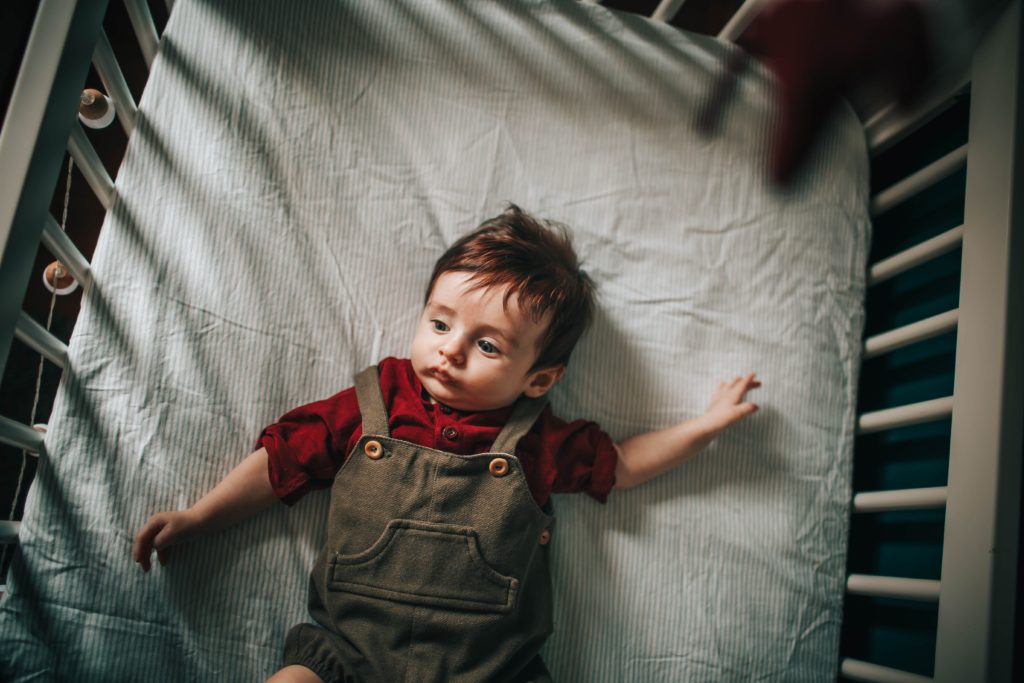
The problem
We already worry about mattresses creating breathing obstructions and causing SIDS, so what more could we possibly fear from a foam slab? Have you ever thought about what’s inside that mattress? Most of us don’t daydream about mattress innards, but for tiny humans who spend most of their fragile lives on it, there’s ample reason to concern yourself with what’s going on inside.
If you’ve ever purchased a mattress, you’re probably familiar with the term “off-gassing;” or if you haven’t heard it, you’ve surely smelled it. As the name implies, new mattresses release a cocktail of specific chemicals known as volatile organic compounds (VOCs) into the air, and foam mattresses are especially noxious. What most of us aren’t aware is that, even after the smell of industrial factory fades, VOCs will continue to emanate from your bed for years and disrupt you or your baby’s health.
These VOCs are used in a multitude of ingredients, ranging from adhesives, flame retardants, polyurethane foam, vinyl coverings, and other synthetic fibers and often consist of chemicals like:
- Formaldehyde
- Benzene
- Chlorofluorocarbons (CFCs)
- Toluene
- Trichloroethane
- Perfluorocarbons
And they all contribute to unpleasant side effects like:
- Several types of cancer
- Nervous system damage
- Liver and kidney damage
Yikes. Definitely not anything you’d ever want a child near, let alone sleeping on for several hours each day.
Unfortunately, identifying these culprits isn’t always obvious, thanks to creative marketing tactics. Companies will slap on buzzwords like “natural,” and “safe,” making them attractive dupes to their pricier counterparts. No one’s enforcing what those words mean, so they might as well be synonymous with “came from planet earth” and “won’t detonate.” In other words, don’t trust the fluffy language.
The solution
Instead, look for certifications like:
- Global Organic Textile Standard (GOTS): the textile version of a USDA organic label
- Greenguard Gold: monitors VOC emissions
- Oeko-Tex Standard 100-CertiPUR-US: Strict standards for foam mattresses
Bear in mind, these certs aren’t bulletproof. Vinyl and bamboo (due to processing) are also toxic, so even if your mattress advertises the certifications above, it still might not make the cut.
Regardless of quality standards, I’d steer clear from foam altogether. After purchasing mattresses for both myself and my firstborn that were Greenguard Gold and CertiPUR-US certified, I still noticed that factory smell on both. Thankfully, my daughter’s mattress didn’t smell nearly as pungent as mine, but it was still covered in vinyl, which can cause birth defects, cancer, and chronic illness.
For a truly safe option, look for products that use:
- Natural latex
- Wool
- Organic cotton
You can’t go wrong with natural materials.
If you’re really pressed for cash, there is alternative, albeit less attractive option: wrap that mattress in food grade polyethelyne (PE). This grade of plastic is durable enough to prevent emissions from passing through so you or your kids don’t have to inhale them all night. You can either pick up some sheeting and do the job yourself; otherwise, some natural vendors will sell premade mattress covers. Just keep the bottom open to “vent” the fumes down and away from the baby. I resorted to this method myself after buying foam mattresses that weren’t as “green” as I was promised, and it’s brought a lot of peace of mind.
Plastic Baby Products – Especially Bottles and Dishes
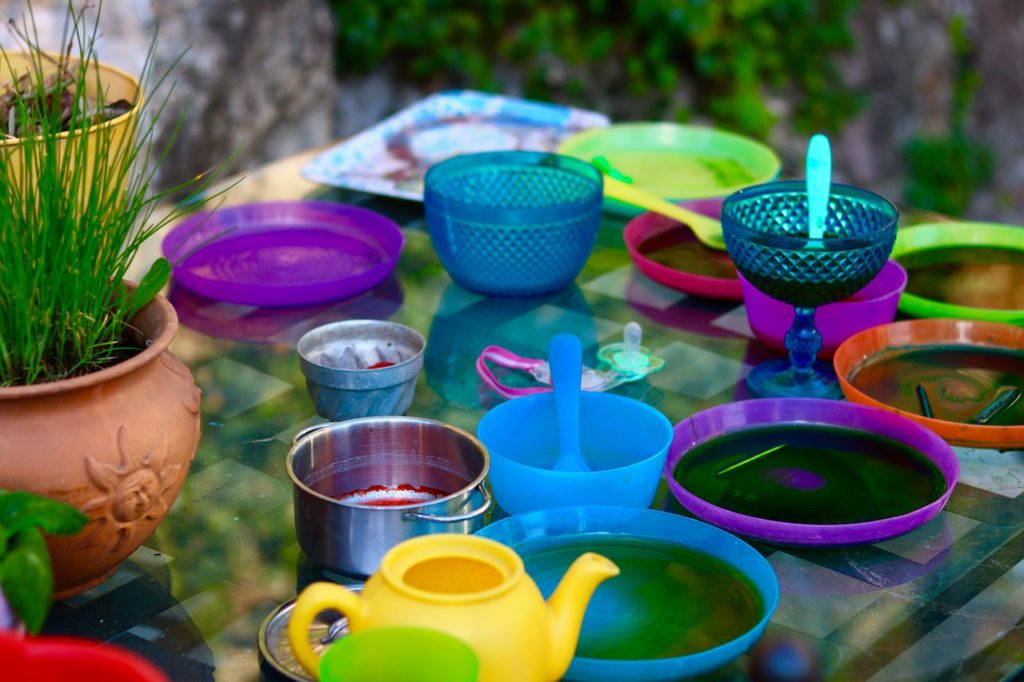
The problem:
With the minor exception of plastic mentioned above please, please stop using plastic, especially on anything that comes into contact with anything your baby will eat or drink. Yes, even the “BPA-free” varieties. They’re little if any better since bisphenol-A is only one of many chemicals in those “safer” plastics capable of interfering with the development of your little one.
Of course, for plastics that still do contain BPA, the biggest concern is hormone disruption via its estrogen-mimicking properties, which can also interfere with other hormones, in turn. This can result in a wide range of complications from reproductive and heart conditions to increased risks for multiple types of cancers, even metabolic diseases like diabetes and polycystic ovarian syndrom (PCOS).
It’s peculiar how pervasive many of these conditions have become among younger generations, isn’t it?
Even products donning the BPA-free stamp of approval still often leach this toxic chemical, which can accumulate in the body.
And if Bisphenol-A wasn’t bad enough, just wait for bisphenol-S and F. Originally created to replace BPA, BPS has increasingly become revealed to be just as, if not more dangerous than even the former. Like BPA, BPS also interferes with cellular functioning, which can cause similar effects as its counterpart; however, BPS may also lead to birth defects.
Plastics (but not exclusively plastics) also contain pthalates, which are also known endocrine disruptors, leading to estrogen dominance, obesity, depression, and more (seeing a pattern here). They’re also implicated in overall early mortality, so if that’s not reason to avoid like the plague, I don’t know what is.
There’s a laundry list of other chemicals, but you get the gist. And when you scan the market in search of baby bottles, prepackaged food, plates, cups, and more, virtually 95% of the market is plastic.
Even some of those newer, trendier materials like melamine should be avoided, as well. Melamine’s a byproduct of coal, leaches into food similarly to BPA/BPS, and in one case, gave infants kidney stones after contaminating their formula.
The Solution
Once again, modernity needs to stop reinventing the wheel and return to materials that have withstood the test of time.
That being said, your best options will forever be stainless steel and glass. And since tiny, inexperienced fingers and glass are a dangerous match, stainless steel has become the standard in my home. Sure, the dinner table may look a little scifi, but it’s a small price to pay for the edge in the battle against their health.
It’s not just plates, though: this includes everything from cups and silverware to storage containers, even toys and other commonly used children’s items. There’s not much we can do about prepackaged food, but the less processed food we consume and the fewer cheap toys we purchase, the less chemicals our children will be exposed to along with it.
Scented Products and Fragrances
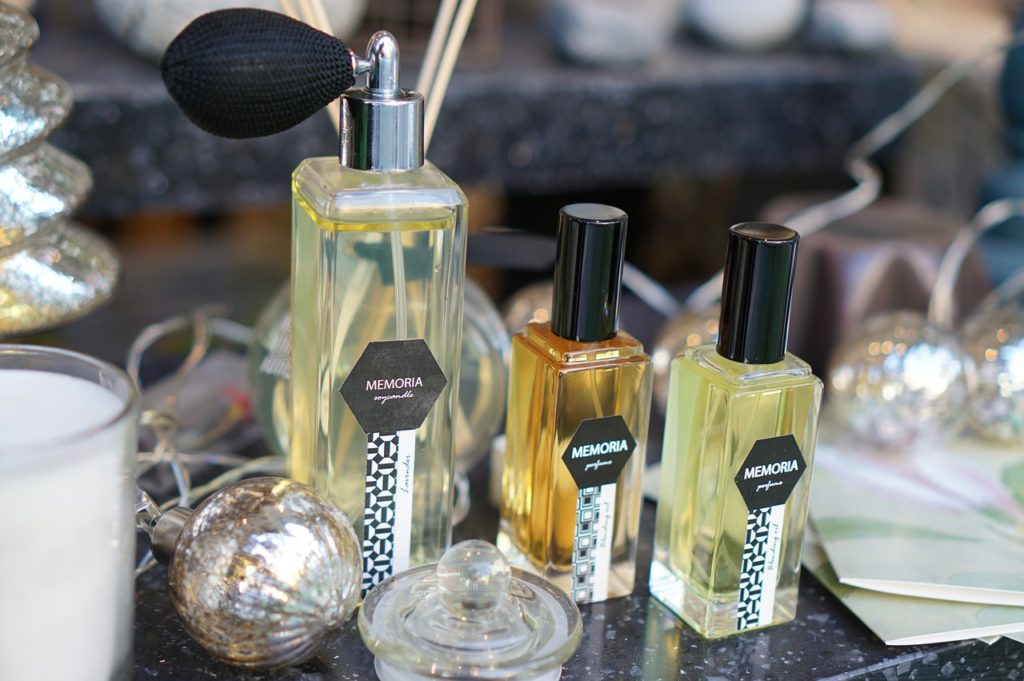
The Problem
Back to those pthalates. Those aren’t strictly in plastics: all sorts of pleasant smelling products are loaded with them, too. In fact, they’re actually what makes good-smelly stuff smell good. Perfume, cleaning agents, laundry detergent, dryer sheets, and air freshener are some of the worst offenders. It may be reflexive to reach for the air freshener after an especially ripe diaper or make liberal use of the dryer sheets, but these products are not subjected to safety testing for their noxious fumes.
In addition to an overall early death, in children, pthalates have been linked to asthma, autism, and kidney, liver, and reproductive damage. And even if the mother is exposed while pregnant, hormone disrupting chemicals of any kind can severely affect a fetus’ sexual development throughout all stages of life. It’s just good practice to phase out these toxic molecules now.
It’s hard – especially when cohabitating with small, booger-eating creatures who conveniently blow out their diapers and fumigate the air the moment you sit down for a hurried five minute lunch, but when their futures are at stake, holding your breath doesn’t seem quite so bad.
The Solution
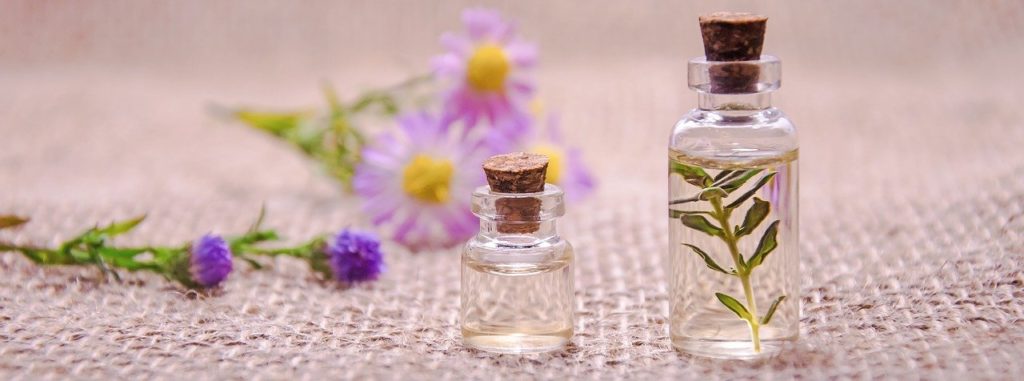
Buy the “free and clear” versions of laundry detergent, and forego the dryer sheets altogether. Make sure all skin and bath products are unscented – body wash, shampoo, lotion. Save perfume for special occasions, and use essential oils with a ultrasonic diffuser instead of spraying air freshener or burning candles made with toxic “fragrance oils” to create the perfect scented ambiance in your home. Opt for wooden toys over plastic as much as possible. Forego new carpet or laminate/vinyl flooring.
I guarantee once you phase out all the artificial smells in your home, all those fragrant candles and detergents will lose their luster – and if you try reintroducing them, the only thing you’ll be able to smell is chemicals, which is exactly what they are. It’s almost like an olfactory reset button.
Formula and Baby Food
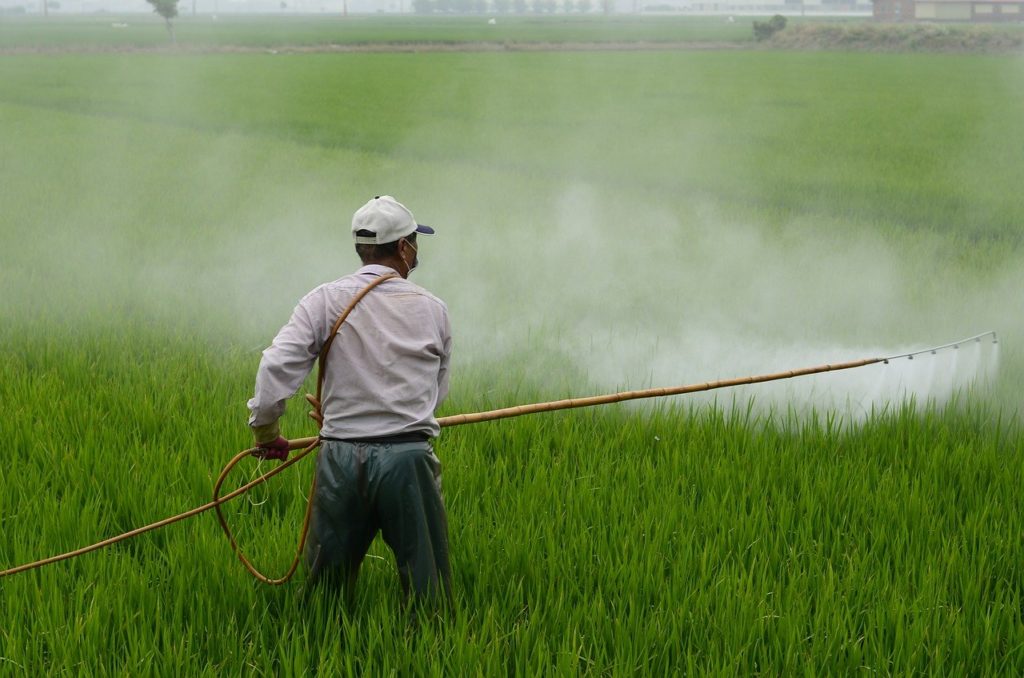
The problem
Every mother’s already heard “breast is best,” but regardless of whether you choose to substitute or supplement, it’s critical to scrutinize your baby’s first foods to safeguard their vulnerable bodies from pesticides and heavy metals that are shockingly common in their products.
Starting with the obvious, organic is a must. Babies’ and children’s bodies are not as adept at expelling contaminants as those of adults, so it’s all the more necessary to ensure they are exposed to as few pesticides and genetically modified ingredients as possible.
While a number of pesticides have been linked to reproductive harm, the most pervasive, the infamous glyphosate (active ingredient in Roundup), can contribute to neurological damage, autism, and auto-immune disease – and these risks are amplified in children.
And though we’ve been exposed to this chemical for several decades now, our magnanimous FDA only just recently started testing food products for its presence. This is why we must remain on the offensive.
As far as baby’s first foods go, conventionally grown oats and soy products are some of the most highly glyposate contaminated ingredients. Although there are federal regulations on pesticide levels, these are both highly debatable levels (as with most pollutants, independent researchers set levels far beneath those of our government), as well as levels that do not consider infants’ under-developed detoxification systems. That being said, most baby food contains varying levels of pesticide residue, with fruit ranking the highest.
Worse yet, 95% of baby food has been found to contain traceable amounts of heavy metals. Rice is a particular concern due to its naturally-occurring arsenic, with brown rice based infant cereal being a “serial” offender (had to!).
Anything that uses any form of brown rice can be problematic, such as flours or syrups commonly found in “natural” products. Unfortunately, in this case, the organic stamp doesn’t pardon this testy grain, but levels in organic products tend to be lower than in conventional varieties.
The Solution
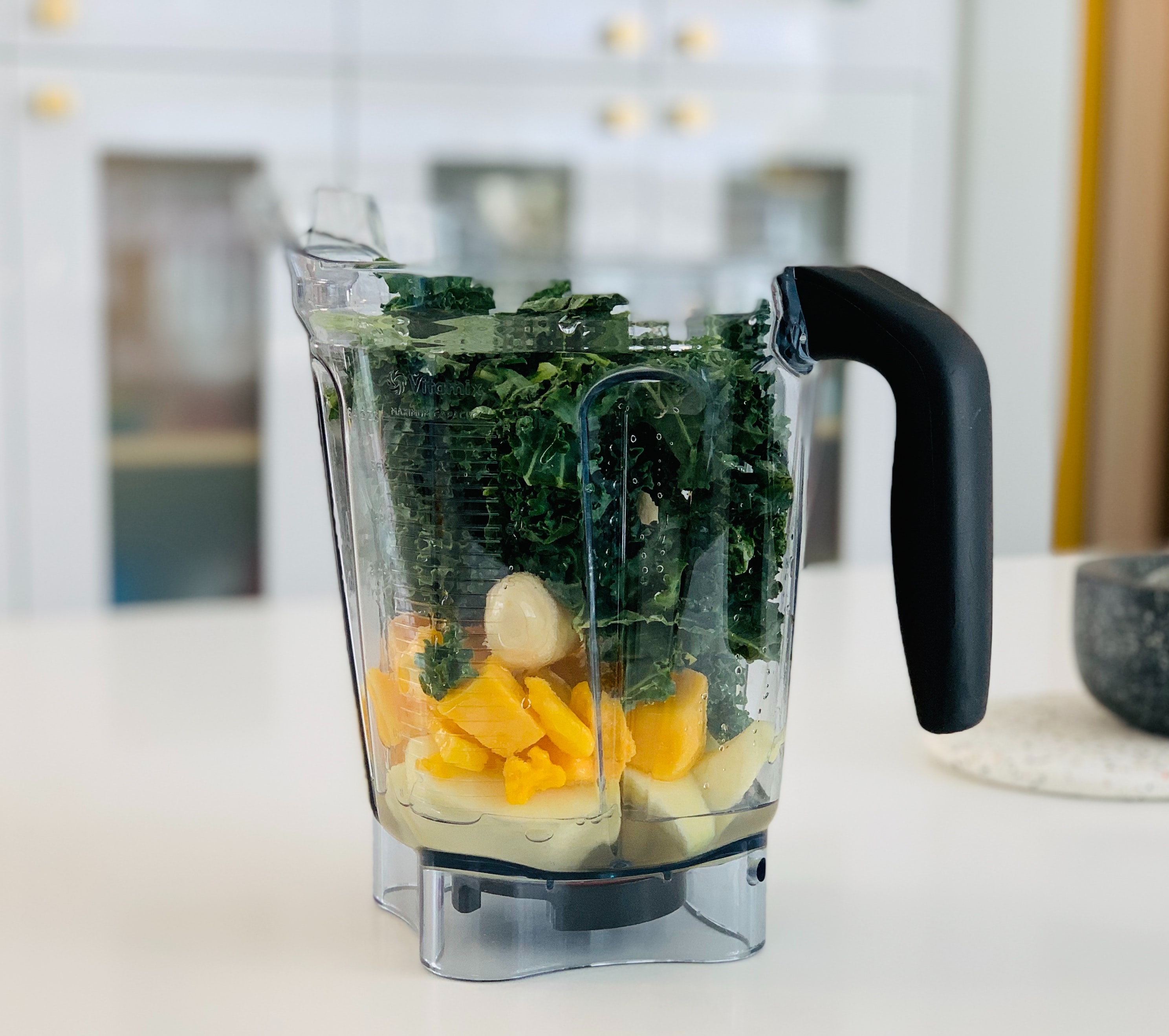
We’ve made it pretty obvious, but avoid:
- Soy products
- Corn syrup (unless organic)
- Brown rice (unless the company lists arsenic levels )
- Conventional (non organic and GMO) oats
- Premade baby food as much as possible
To add: one brand I consistently see on the glyposate and arsenic “naughty” list is Gerber, so it’s probably best (and easiest) just to avoid them altogether. Just because a product has a cute little baby’s face under the label does NOT mean it’s child safe. Sad, I know.
Instead, breastfeed as long as possible if you can (and yes you CAN do it at work!! Living proof here – pumps are a godsend). Alternatively, look for formulas that meet the following criteria:
- Organic
- Soy-free
- Palm oil-free
- Carageenan-free
- Non-hexane extracted DHA
- Corn syrup and sucrose-free
- Brown rice syrup-free
- Lactose or milk as first ingredient
- Contains omega-3 and Omega-6
It’s not perfect, but it’ll cut out most the bad stuff. Also, pretty much anything you receive as a free sample (you know, the bathtub’s worth of formula the hospital send you with) is also going to land on the no-no list. It doesn’t hurt to add it to your SHTF prepper stash, though.
Again, buy organic as much as possible – oats, rice, other grains, produce, specifically fruit.
Preparing your own baby food doesn’t have to be a hassle, either. In fact, it’s super simple with the right gadgets. There are a few companies that sell two-in-one glass steamers and blenders, so all you have to do is add produce, press a button, and serve. They seem pricey at first, but after you factor in the premium price of baby food, they will absolutely pay for themselves. Heck, I still use mine for making applesauce.
Water
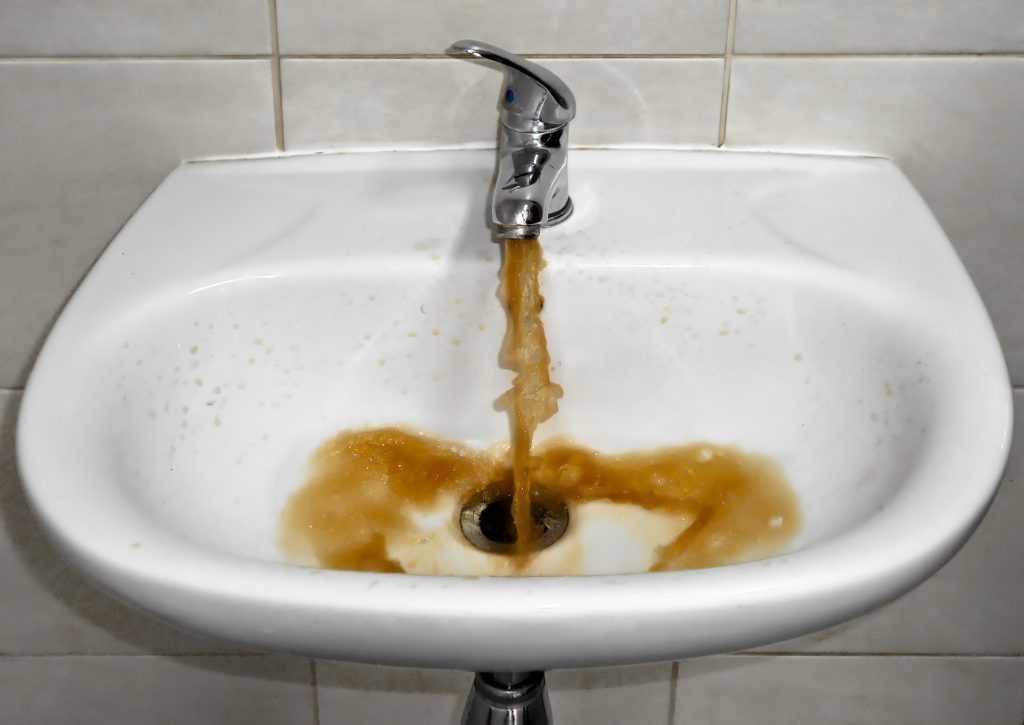
The Problem
If you think the crisis that happened in Flint, Michigan several years back was an isolated event, I’ve got bad news: most our public drinking water is contaminated with obscene levels of more chemicals than you ever knew existed, and our public health officials aren’t in any hurry to respond to that simmering dilemma.
In fact, our water supply contains roughly over 300 toxic contaminants, many of which are several hundreds of times above the limits set by the EPA.
Some of these foul pollutants include:
- Pesticides, like glyphosate and atrazine, the latter of which can cause reproductive disorders, hormonal disruption, birth defects and cancer
- Per- and polyfluoroalkyl substances (PFAS) or carcinogenic “forever chemicals” that also cause birth defects and reproductive disorders among other health complications
- Heavy metals – this includes arsenic, lead, cadmium
- Radioactive materials – like radium
- Birth control hormones – it sounds absurd, but all the elevated estrogen and progesterone from “the pill” alters our reproductive health as well that of aquatic life.
- Fluoride – though a topic of controversy, the risks of fluoride in drinking water do not outweigh the “benefits” unless you consider a 7 point reduction in IQ a reasonable trade-off
- Microplastics – a smaller version of what we just finished discussing
- Plus hundreds of other chemicals
It’s also important to note that even if the municipal water treatment centers are efficient enough, your water has plenty of opportunity to accumulate contaminants like copper and lead as it travels through the pipes.
The solution:
Don’t reach for that brita filter just yet: not all filters are created equal. And sadly, the vast majority won’t make the cut for protecting a developing brain. Bottled water isn’t any better, either, as a large portion is actually rebottled tap water (which should be a crime) or still contains many of the contaminants listed above, especially microplastics and fluoride. Since it’s a hotter topic, it needs to be emphasized that there is no reason under the sun a baby with five teeth needs fluoride, so it is imperative to make sure whatever filtration device you choose specifically mentions that, as well.
When purifying your water, these are your options:
- Reverse osmosis
- Distillation
- Specialized* carbon filters – *Note: the brand Clearly Filtered uses a proprietary type filter that bypasses the whole setup required by RO and distillation systems. They don’t remove 100% of fluoride, but they come pretty darn close. They also sell filtered water bottles for adults and kids, which you’ll want to have ready for daycare or kindergarten. I’ve been using this brand for over 10 years and can’t recommend them enough. Try them out and get 25% off your first filtration system by clicking here.
You can also check your area for water contaminants just to get an idea where you stand. Again, considering all our water is fluoridated, no matter how “clean” it may appear, you still need to eliminate it when a developing brain is at stake.
Your gadgets
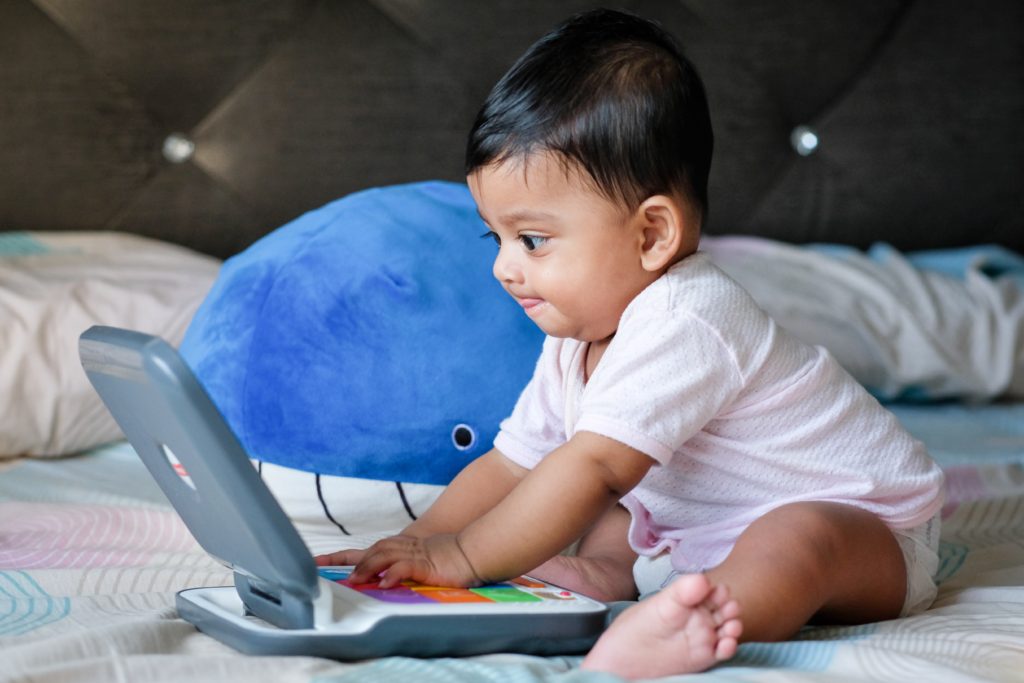
The problem
What would this site be without mention of electromagnetic radiation (EMR)?
This cannot be stressed enough: please, for the love of all that is too young to protect itself, do not use your devices around your little ones! There is a memory seared into my mind of a woman I saw at Costco a few years back who was standing in line with a newborn sleeping in its car seat perched atop the cart, and propped up directly on the baby was her phone. She was literally using her child as a phone rest while she scrolled through instagram.
Dear reader, that made my heart ache. She might as well have been blowing smoke from a cigarette directly into the baby’s face. EMFs are terrible for your health, and they are disastrous for any biological being whose cells are still rapidly dividing.
You can read more about it here, but even before birth, exposure from devices and transmitters can:
- Interfere with brain development, as there is an increasingly strong link between exposure and autism
- Alter sleep patterns, which can lead to the above
- Cause hyperactivity and attention deficit disorders
- Hinder their reproduction later in life
- Impair immune function
- Greatly increase their risk of multiple cancers
- And, of course, cause physical and mental distress since babies and children are far more sensitive than we are
And that’s just the tip of the radiation iceberg. So how do we keep our little creatures safe?
The solution:
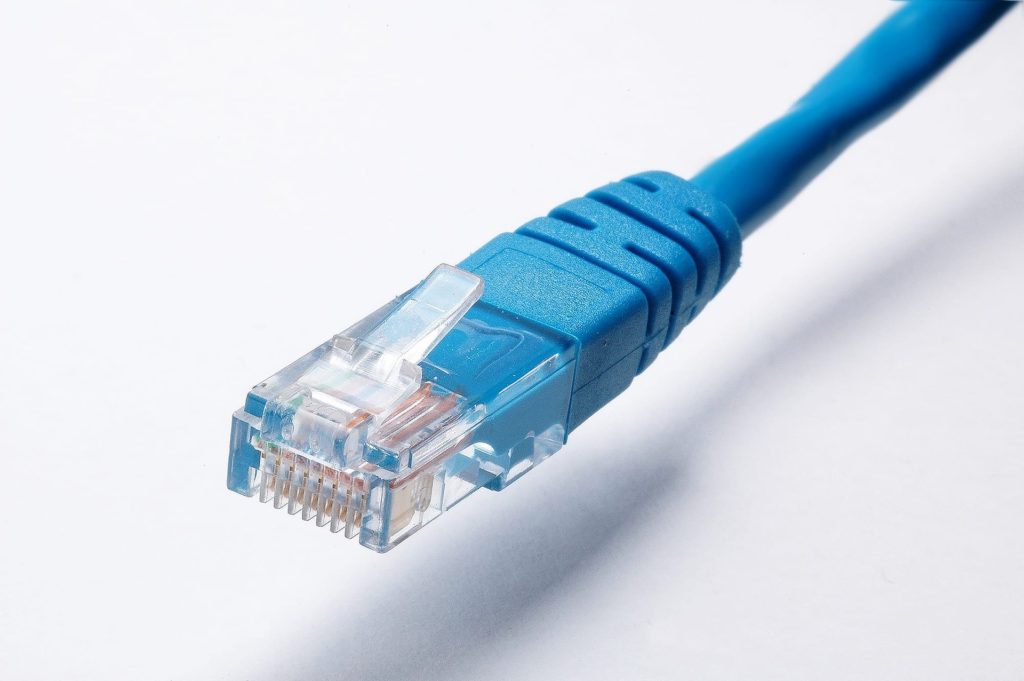
Pledge to never become Costco lady. Since small children treat us like fleshy jungle gyms, always be mindful of where your baby or kids are when using your phone. Scrolling while breastfeeding is also a huge no-no: just sit down on a wired computer instead.
Use wifi as minimally as possible; unplug it at night, or convert to ethernet cables. In fact, any device you could ever need to live has a way to connect via ethernet (which is a more reliable connection anyway). Adapters exist for all sorts of gadgets.
If you’re pregnant, treat yourself like the baby and protect that bump like your life depends on it. Ditch the wearables, including bluetooth headphones: they’re emitting way too much EMR. You don’t need any more bombardment in your life anyway.
In spite of their namesake, never place laptops directly on top of your lap. That’s way too close to your reproductive organs.
Avoid using baby monitors. Their EMF output is astoundingly strong.
Make sure your home is a safe distance from cell towers, radio transmitters, 5G towers, high voltage power lines, electrical substations, and the like. Check out this article for more specifics on safe distances and how to responsibly use your devices because the manufacturers sure won’t help you.
Essentially, if it’s device, any device at all, it will emit some form of frequency, all of which are detrimental.
A Final Word
Now that we have far fewer threats to fear than our ancestors, like infectious diseases, war, and infections from minor wounds, it’s easy to grow complacent and blindly trust the safety of the four walls around us. It’s much harder measure the damage of a chemical that subtly contributes to chronic illness or cancer, but with so many blind spots in our public health’s view and so many of these illnesses exploding in prevalence, we need to stay a step ahead.
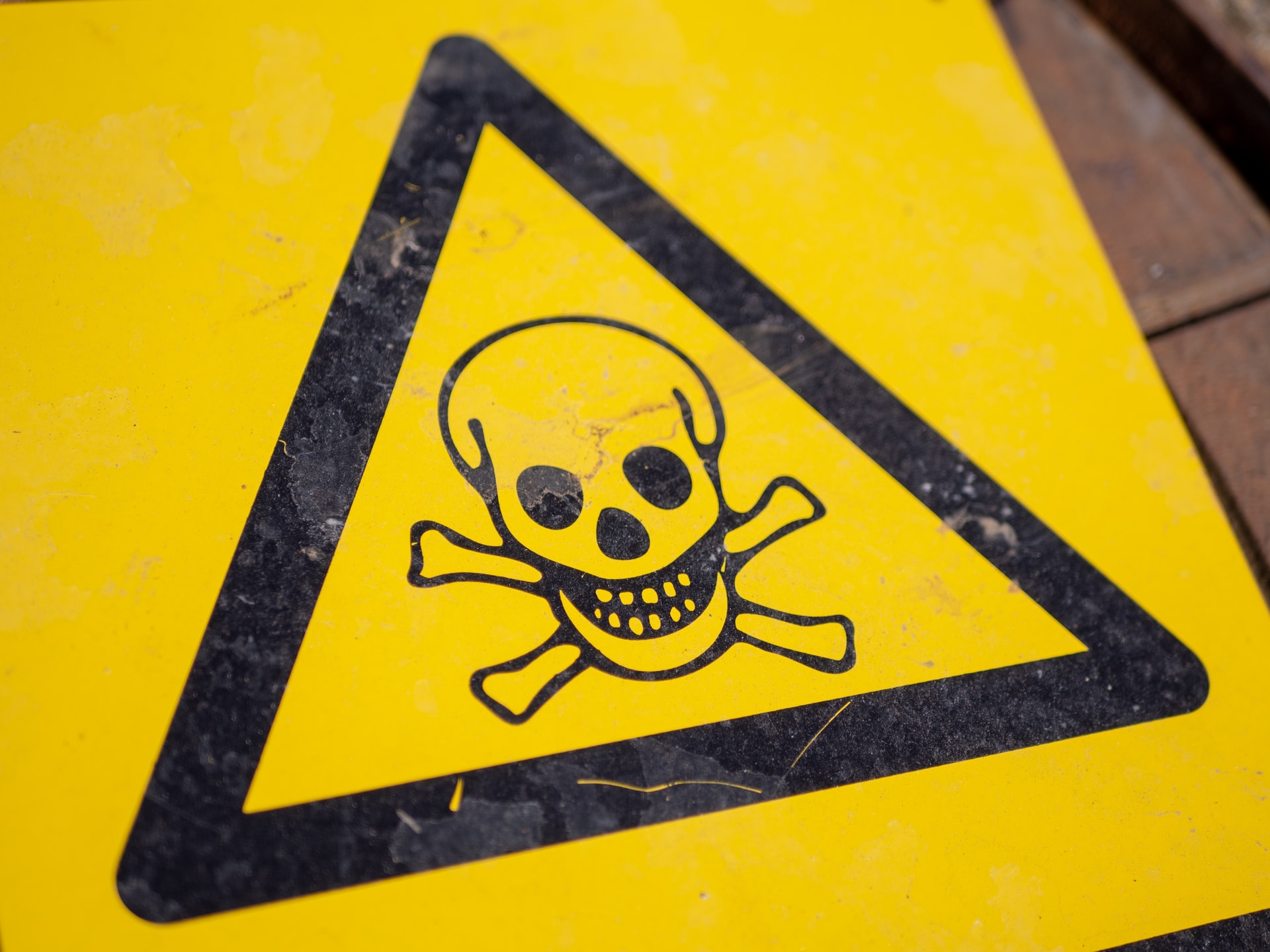


It is in point of fact a great and helpful piece of info. I am satisfied that you simply shared this helpful info with us. Please keep us informed like this. Thank you for sharing.
It’s a pity you don’t have a donate button! I’d without a doubt donate to this superb blog! I guess for now i’ll settle for bookmarking and adding your RSS feed to my Google account. I look forward to fresh updates and will talk about this site with my Facebook group. Talk soon!